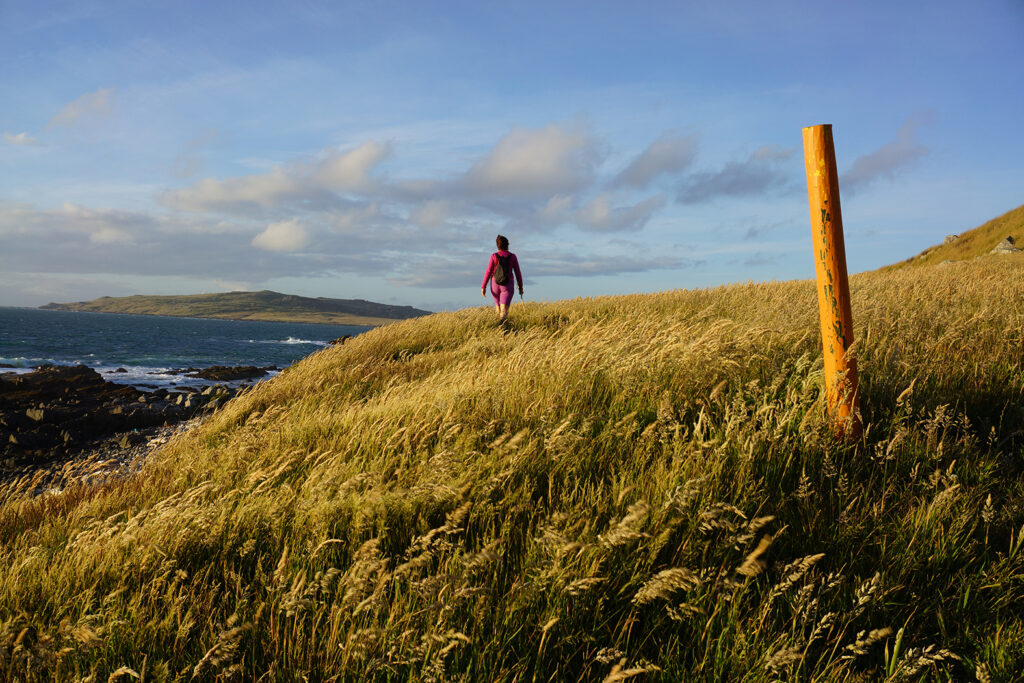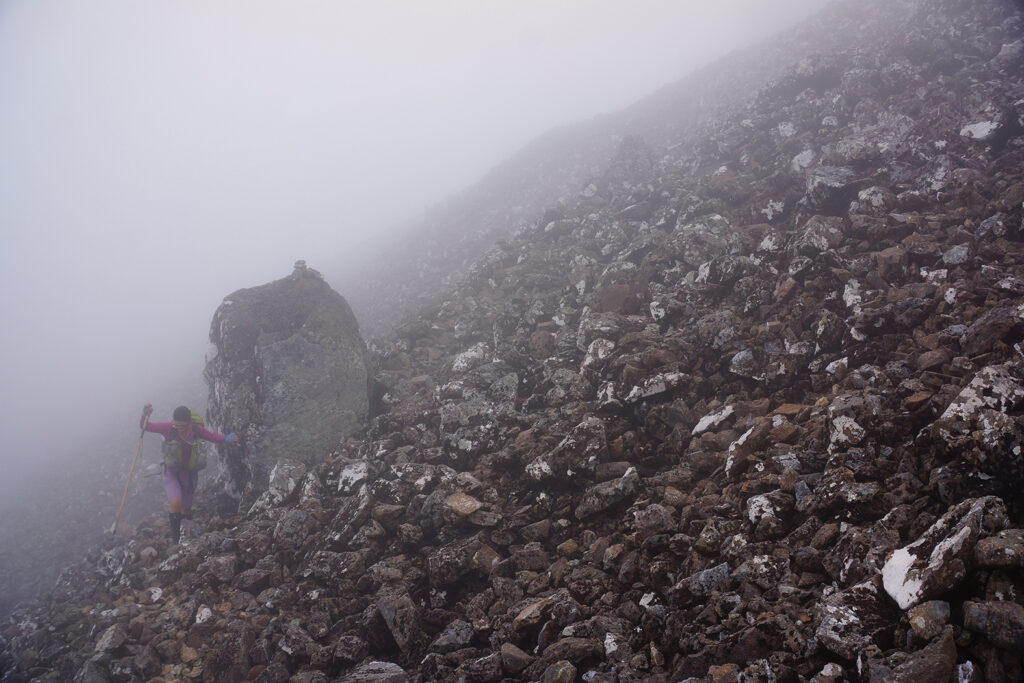In 2015 Anthony Behrens and Fiona Burleigh left Bluff on an adventure that changed their lives forever.
About 15 years ago my partner Fiona and I got into tramping. We’d done it as teenagers but as parents we didn’t have the resources or energy to continue, even though we’d both loved it. Dragging our kids up mountains wasn’t something we hankered after either … much to their relief no doubt.
We would have been content being middle-aged trampers, but a series of coincidences literally changed our path. Bill Bryson’s story of hiking the Appalachian trail, A Walk in the Woods, played on National Radio, we stumbled on a book about the Camino de Santiago and then New Zealand’s own pilgrimage, Te Araroa, decided to snake its way through our town. Our curiosity was piqued. We were about to become hikers.
On a beautiful day, late in 2011 Fiona and I drove to Feilding and walked back to Palmerston North along Te Araroa’s brand new route.
It was awful. The traffic was unforgiving, the walking was mostly on rough grass verge. The litter, pollution and liberal use of weed killer made for unpleasant scenery. But we were hooked.
One comment Fiona made that day really stood out: ‘The sky is really big out here.’
As we stumbled along and the cars hurtled by we discovered our scale in a world shrunken by machines. We felt human and connected with the planet in a way that driving, cycling and living in suburbia all mask.

As painful as the walk was, it was the first time we’d ever experienced what distance must have meant to our ancestors. Without getting too cosmic, it was an awakening.
In 2012 we met our first trail walkers, two Germans, Franziska Wernsing and Jonah Riechmann and a French woman Melanie Delpont. They were doing a side trip around Mt Ruapehu when we all coincided at Rangipo Hut.
A few weeks later they came and stayed at our house beside the trail in Palmy. They and their journey fascinated and inspired us. We had originally thought we would “do” the Camino, but their visit made us realise what we had right here. Why fly across the world when we had Te Araroa at our front door?
It takes about six months to walk the length of New Zealand in one hit but the great thing about being locals is that you can pick off bits of trail as your schedule allows. People who do this are called Section Walkers. It’s been estimated that there are two thousand dedicated Section Walkers doing the trail at any one time.
This is how we originally planned to walk Te Araroa. After our Fielding to Palmy section we slowly pieced together 95% of the trail to Wellington.

It quickly became an obsession that inevitably meant a bigger trek. Once we’d taken 10 days of food into the Tararua as a test run for the Richmond Range, we knew we could walk the South Island leg in one go and a date was set.
Apparently it was my idea. Which was good, because if I hadn’t suggested it, my involvement in our preparation would have been negligible. This may seem unfair and a bit lazy of me, but we make the perfect team.
Fiona organises the whole kit and caboodle and I oblige by turning up and going ‘Wow!’.

We chose to walk the South Island from Bluff to Ship Cove so Fiona had to write the official Te Araroa trail notes backwards (they used to only refer to a south-bound ((Sobo)) route). We’re not ultra-light hikers, but we’re not stupid either. This meant Fiona got to go shopping with a set of digital scales – weighing everything from cookers to undies. We still carry some weighty creature comforts and wear heavy tramping boots, but our kit is pretty light now and every gram saved is testament to Fiona’s number-crunching.
We finally set off in January 2015.
Walking north-bound (Nobo) from Bluff was probably our best decision. It meant we met many of the season’s often exotic walkers as they came the other way – our days were seldom lonely and were often full of chatter and what we called ‘trail gossip.’ We’d find out who was coming our way and learn about the adventures of our Nobo mates.
At a probably incorrect guess, about 250 through-walked the South Island that year, with only about 25 Nobo. The small group we walked with became quite tight and we formed friendships that will last for life.
Some of those people included:
Anna McNuff, a young English woman who sang, joked and ran (yes ran) the entire trail (and more) carrying a 15 kilo pack.
Ron Sherk, a 65-year-old Canadian retired forestry worker. He not only walked most of the trail, but cycled to several roadends on a cheap Warehouse bike and buried supplies for retrieval as he walked through. Ron also carried a carbon fibre guitar and entertained lucky hutmates with a seemingly limitless repertoire of cowboy, folk and pop songs.

Peter Race and Andrew Amador Corrales, two American hard-core trail walkers who thought nothing of carrying 30kg+ packs full of all the home comforts a couple of boys from San Fran need – including pyjamas, eggs and chilli sauce.
The social side of the trail was our biggest surprise. Walkers have an instant bond and trackside meetings could easily last an hour. Groups of walkers in huts can be quite exclusive, which often comes across as rude to trampers and hunters, but the camaraderie of what is an extreme physical and emotional shared experience makes this a frequent occurrence.
We met plenty of characters in our many brief encounters with sobos. A standout was Jory Akuhata, an ex-Palmy boy who walked three quarters of the trail in barefeet and made much of his own gear – including sunglasses and pack from found objects and flax.
Americans have a reputation for travelling fast and with minimal gear, but one of the fastest and lightest we met was Kirstine Collins, an ex-New Zealand army ultralite hiker. Her base pack weight was 6.9kgs and her maps and notes became eagerly traded treasures amongst hikers.
Our 70 days walking to Ship Cove changed our perception of time and distance completely, but it also gave us an intimacy with our country that car travel can’t. Every track, hill, mountain, stream, lake and river seemed to become part of us as we trudged through and past them.

We’re often asked what our favourite parts of the trail were. The rugged and lonely Takitimu and the tough Richmonds stand out but we were really impressed with the rejuvenation of the “reclaimed” Tenure Review areas we walked through. Tussock, shrubs and birdlife seemed to be blossoming in areas once ravaged by sheep. Yes, rabbits and hieracium are destructive, but take sheep out of the picture and some form of natural balance seems possible.
There were two lowlights of the trail for us. The last couple of weeks were difficult – I’d lost 11 and a half kilograms of weight and came out of the Richmonds absolutely exhausted. As we wandered toward the tip of Queen Charlotte Sound we both started to prematurely mourn our return to normal life.
We also found tourist centres really hard to handle. Not only did we bleed money – desperately eating big breakfasts and drinking cider – but we found the throngs of experience-seekers depressing. Of course we were tourists too…but our “suffering” and general state of disrepair made us feel at once a little “holier than thou” and untouchable at the same time. We were like fly-blown snobs.
Our few hours in Wanaka consisted of me working on our blog in a hot windowless computer cafe, while Fiona washed, then dried our underwear on the footpath outside a bar full of drunk tourists. We got out as soon as we could.
Occasionally we used cars and bikes while on the trail – they seemed like time machines, transporting us miraculously across the world in the blink of an eye. The world now seems strangely smaller and bigger at the same time, a feeling that has lasted. A walk into town is no longer a drag … it feels like freedom.
Not everyone who trail walks has such a life-changing experience, but many do. Perhaps that’s why pilgrimage is so closely associated with religion, but perhaps we’re just addicted to trail walking because of the huge amount of endorphins our bodies produced every day. Perhaps we’ve just found our inner masochism.
Te Araroa is a long, thin red line on a map of New Zealand. It’s an imperfect line in places, and it will change its route over the years. In the slow and often solitary world of walking, it’s becoming a bit of a highway. Hopefully you’ve read this and now understand why.
A slightly different version of this article first appeared in the Federated Mountain Clubs of New Zealand’s Backcountry magazine.


